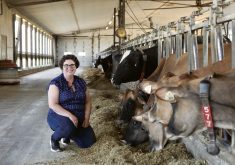It used to be that artificial intelligence was limited to the realms of science fiction and movies like 2001: A Space Odyssey or Terminator’s Skynet.
Today, artificial intelligence is real — think Alexa or Google Home — and tools and applications putting it to use are emerging at a rapid clip in many fields, including agriculture and food.
Artificial intelligence is an umbrella term for machine learning but its concepts are used in related fields, including robotics and natural language processing.
It certainly figured prominently at this year’s Global Food Innovation Summit in Italy, which I was able to attend with the support of a bursary from the Canadian Farm Writers’ Federation professional development fund.
Read Also

Riding the tariff rollercoaster
Farmers are accustomed to roller-coaster years. But the current geopolitical windstorm is something else entirely. On his cattle operation near…
“It will take resources to tackle problems we face like climate change, food security and hunger,” said Zachary Fritze, CEO and co-founder of ag tech analytics startup Cultovo, during a presentation at the conference. “Artificial intelligence is a solution where we can achieve all of that faster, smarter and cheaper.”
In farming and ag tech circles, artificial intelligence mostly focuses on optimizing the actual outputs of farming — growing more and better food more sustainably by using fewer resources, whether that’s fertilizer, pesticides or water, or even labour.
Less attention is paid to how it’s changing the food we eat once that food actually leaves the farm, but developments here are also evolving rapidly.
Let’s look to the farm level first for a few examples of artificial intelligence in action.
Earlier this year, Dutch sprayer manufacturer Agrifac launched its newest self-propelled sprayer, a unit that sprays only where it “sees” weeds that it recognizes instead of spraying the entire field. That can cut pesticide use by up to 90 per cent, says the company, reducing costs for farmers and creating more-sustainable food production.

Even better, a system of cameras mounted on the sprayer’s booms snaps and analyzes images in real time to identify the weed species and to provide a customized spray response. It’s based on smart weed detection and artificial intelligence technology from French startup Bilberry.
Ida, a new dairy cow monitoring system from the Netherlands, uses individual sensors to collect cow data. It sends that data to the cloud for analysis, identifies problems, and then generates recommendations and solutions for the farmer.
Ida learns seven different cow behaviours — from walking and standing to eating and drinking — for each cow to provide individual health insights so farmers can detect and treat health problems more quickly.
Meanwhile, University of Guelph computer science professor Rozita Dara is using artificial intelligence to mine social media chatter for clues where the next avian influenza outbreak might occur. It works with an automatic crawler that continuously gathers tweets from across Twitter and uses artificial intelligence to screen for applicable posts.
Fruit and vegetable growers having a hard time finding farm workers could also find solutions in the artificial intelligence realm. Various companies in Europe and the United States are working on smart strawberry-picking robots that use imaging to identify ripe fruit and artificial intelligence to create efficient picking strategies.
In Ontario, Vineland Research and Innovation Centre is working on a prototype for an intelligent, automated apple picking system that will identify individual apples and assess their readiness for picking. They’re also developing similar technology for mushroom harvest, as well as a smart irrigation system for greenhouses that can be “trained” by the grower to water according to environmental conditions instead of simply following a prescribed regimen.

Your food, too
At the consumer end of the food chain, artificial intelligence can convince people to eat differently in order to address growing health problems like obesity and diabetes.
“We have to change habits, but people won’t do it unless the food is really delicious,” said Johan Langenbick, co-founder of Foodpairing, a creative food tech company. Their technology creates personalized recipes by having a machine mimic human creativity and perception of flavour and connecting that to user input of foods and tastes they like and don’t like.
Foodpairing has been digitizing flavour for almost a decade to create one of the world’s largest flavour databases of over 2,500 ingredients and more than 8,000 aroma molecules. Using this information, smart algorithms calculate novel recipes by finding similar flavours in foods that people wouldn’t normally pair together, such as strawberries and asparagus, for example.
Indian startup Dishq, a taste prediction technology company, is using artificial intelligence and consumer data to give restaurants, in-house cafeterias and food delivery companies the power to offer customers personalized food choices.
According to CEO Kishan Vasani, individual food preferences are as unique as fingerprints, and factors that influence your perception of taste and flavour include biology, psychology and ethnicity, as well as real-time contexts like weather and price.
Artificial intelligence can help the food industry understand why a product is or isn’t popular, as well as enable the creation of unique flavour profiles — such as soy sauce with popular hazelnut spread Nutella.
“Based on the aroma compounds they share, there is an 80 per cent similarity between soy sauce and Nutella so we tried to validate what the artificial intelligence told us with a taste test,” Vasani said. “Now we are creating noodle recipes in Asia using Nutella and soy sauce.”
Giving food producers and companies predictive information for product development is the next step, Vasani believes, along with menu-less restaurants that will tailor food offerings to a person’s individual taste passport.















